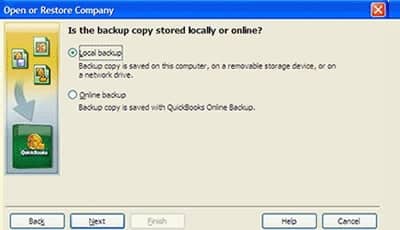

- #QUICKBOOKS FOR MAC WILL NOT OPEN BACKUP FILES PRO#
- #QUICKBOOKS FOR MAC WILL NOT OPEN BACKUP FILES PASSWORD#
It does this because you will likely be deleting the most current copy of your company file. Then QuickBooks confirms you want to do this by making you type the word “YES” into the text box in the “Delete Entire File” window. You can click “Yes” in the message box that appears to overwrite it. If overwriting a corrupted company file, QuickBooks may ask to overwrite the file. After selecting the company file to overwrite, click the “Save” button. Next, use the “Save Company File As” dialog box that appears to navigate to, and select, the corrupted company file to overwrite with the selected backup copy’s data. Restore a QuickBooks Company File from a Local Backup: A picture showing the alternative method of selecting a local backup copy to restore in QuickBooks Desktop Pro. After reading the information within this screen, click the “Next” button to continue. Using this method also lets you choose a local backup copy for the restore procedure from the Menu Bar and then jump immediately to this screen within the “Open or Restore Company” window.

Then select the name of the desired local backup file to use from the side menu of choices that appears. You do this by choosing “File| Back Up Company| Restore Previous Local Backup” from the Menu Bar. You can also reach this screen in an alternative manner than the one described this far. The “Open or Restore Company” window then displays the “Where do you want to restore the file?” screen. You will then return to the “Open or Restore Company” window. After selecting the file to use, click the “Open” button in the “Open Backup Copy” dialog box. Use this dialog box to navigate to and then select the local backup copy to use for the restore process. QuickBooks then opens the “Open Backup Copy” dialog box. After making your choice, click the “Next” button to continue. For this example, we will select the “Local backup” option. If you saved the backup copy online using that feature, select the “Online backup” option button, instead. This is a backup saved to your network or to removable media. Select the “Local backup” option button to restore a QuickBooks company file from a local backup. The next window asks where you saved the backup copy you want to use. Restore a QuickBooks Company File from a Local Backup: A picture of a user selecting to restore a backup copy in QuickBooks Desktop Pro. Then click the “Next” button to continue. So, select the “Restore a backup copy” option button. In this situation, you want to restore your data from a backup copy. To restore a QuickBooks company file from a local backup, select “File| Open or Restore Company…” from the Menu Bar. You must then re-enter all transactions that occurred from the date you created the backup copy through the current day to bring your company file up to date. When you restore a QuickBooks company file from a local backup, you overwrite your corrupted company data with the data from the local backup copy.
#QUICKBOOKS FOR MAC WILL NOT OPEN BACKUP FILES PASSWORD#
If you did not create a password for the administrator account before attempting to restore a QuickBooks company file from a local backup, you must create one as part of the restore process. Sensitive data includes credit card numbers, social security numbers, or FEIN information, for example.
#QUICKBOOKS FOR MAC WILL NOT OPEN BACKUP FILES PRO#
In addition, QuickBooks Desktop Pro requires you to enter or create a password for the “Administrator” user before you can restore a QuickBooks company file from a local backup that contains sensitive data. You must be in single-user mode to do this.

Doing this lets you repair a corrupted company file in QuickBooks. You can restore a QuickBooks company file from a local backup copy, if you created local backup copies. Restore a QuickBooks Company File from a Local Backup: Overview


 0 kommentar(er)
0 kommentar(er)
